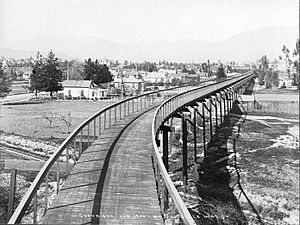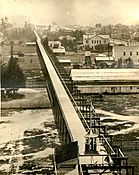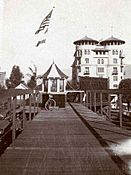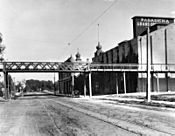California Cycleway facts for kids
The California Cycleway was a special elevated road built just for bicycles. It opened in 1900 in California, United States. This unique path was planned to connect the cities of Pasadena and Los Angeles. It was about 9 miles (14.5 km) long and was a toll road, meaning you had to pay to use it.
Contents
Building the Cycleway
Who Had the Idea?
The idea for the cycleway came from Horace Dobbins, an inventor and promoter who lived in Pasadena. He got Henry Harrison Markham, a former governor of California, to join him in this big project.
Getting Started
Horace Dobbins and Henry Harrison Markham asked the California state government for permission to build the cycleway. After a first try was stopped, they finally got approval in 1897. The California Cycleway Company then bought a 6-mile (10 km) strip of land for the path. This land stretched from downtown Pasadena to Avenue 54 in Highland Park, Los Angeles.
Construction Begins
Building the cycleway needed a lot of wood! The first boat carrying lumber arrived in San Pedro in September 1899. More wood arrived in October. The company stored all this lumber near the railroad on Glenarm Street.
On November 4, 1899, a carload of nails arrived. Just three days later, on November 7, a team of 15 workers started building. They placed the first concrete supports for the cycleway near Raymond Hill. A steam sawmill was set up to cut the wood. A special machine called a portable derrick helped them build about 300 feet (91 meters) of the path each day. By the end of November, about half a mile (0.8 km) of the wooden frame was finished.
Opening Day
The first part of the cycleway, about 1.3 miles (2.1 km) long, opened to the public on January 1, 1900. It started at Pasadena's Hotel Green and ended near the old Raymond Hotel. The first people to ride on it were Reverend Otis Bedell and 12 other cyclists. The Los Angeles Herald newspaper reported that nearly 1,000 people rode on the path that day. They estimated that 1,500 trips were made without any problems!
What It Looked Like
The part of the cycleway that was built was made almost entirely of strong Oregon pine wood. It was wide enough for four cyclists to ride next to each other. The plan was to make it even wider later. The path was painted dark green and had bright lights at night.
Using the cycleway cost 10 cents for a one-way trip or 15 cents for a round trip. If the whole path had been finished, it would have gone through Montecito Heights, crossed the Los Angeles River, and continued to the Plaza in Los Angeles. The highest point of the path was 50 feet (15 meters) above the ground.
- The California Cycleway
Why It Closed Down
The California Cycleway never made enough money. This was for a few reasons:
- Bicycle Craze Ended: The huge popularity of bicycles in the 1890s started to fade.
- New Transport: There were already Pacific Electric Railway lines connecting Pasadena to Los Angeles, which were easier for many people to use.
Because of these reasons, the cycleway was never extended beyond the Raymond Hotel. In the early 1900s, the wooden structure was taken apart. The wood was sold for other building projects. The land where the cycleway stood later became part of the Arroyo Seco Parkway (also known as the Pasadena Freeway).





